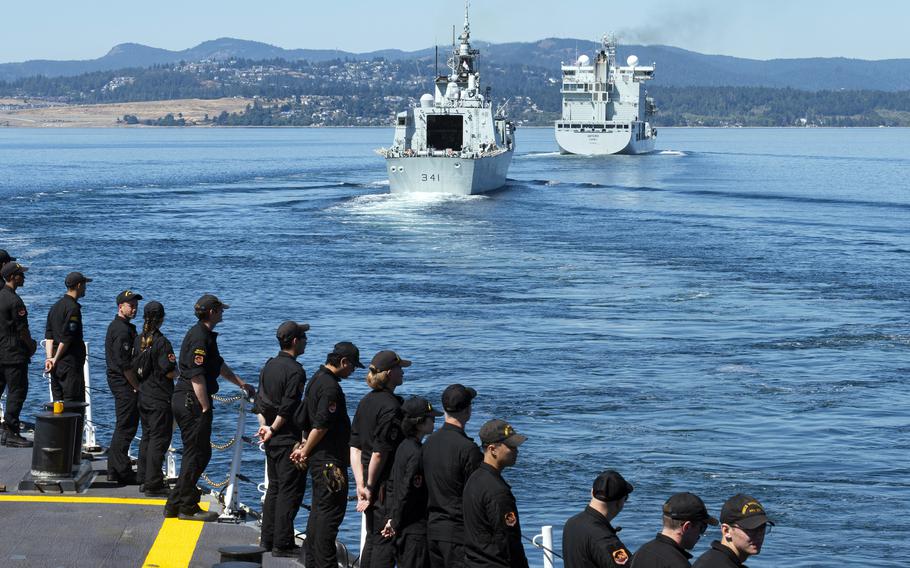
The Canadian supply ship MV Asterix and frigate HMCS Ottawa lead the way for HMCS Vancouver after departing for the Indo-Pacific on Aug. 14, 2023. (Alisa Strelley/Canadian air force)
YOKOSUKA, Japan — Three Canadian navy ships steamed into Tokyo Bay this week, signaling the start of a monthslong patrol of the Indo-Pacific as part of the country’s efforts to expand its presence in the region.
Two frigates, the HMCS Ottawa and HMCS Vancouver, and the replenishment ship MV Asterix arrived Monday at the Japan Maritime Self-Defense Force’s naval base in Yokosuka, Vancouver spokeswoman Capt. Veronique Sabourin told Stars and Stripes by phone Thursday.
“We’re happy to be here, to work with partner nations in order to enhance security in the region,” she said. “The Royal Canadian Navy has a proud history of being present in the Indo-Pacific region.”
The ships left Canada on Aug. 14 for a five-month deployment, according to a news release from Canada’s Department of National Defence. The Ottawa and Vancouver are the second and third warships to deploy to the Indo-Pacific this year; the frigate HMCS Montreal returns to Halifax this month, according to the release.
The three recently arrived ships may depart this weekend for a surveillance mission near North Korea as part of Operation Neon, a multinational effort to enforce the U.N. Security Council’s sanctions against the isolationist country, Sabourin said.
The ships will look for “suspected maritime sanctions evasion activities,” such as ship-to-ship fuel and commodities transfers banned by the U.N., according to the Canadian National Defence Ministry website.
Other participant nations are the United States, Australia, France, Germany, Japan, South Korea, New Zealand and the United Kingdom.
The Canadian ships are expected to take part in additional patrols, training and exercises during their time in the region; they’re also expected make port visits in the Philippines, South Korea and elsewhere in Japan, Sabourin said.
U.S. 7th Fleet spokesman Lt. Luka Bakic in email Tuesday declined to comment on the ships’ arrival, their movements or operations, except to say that the 7th Fleet routinely operates with allies and partners “and will continue to do so.”
Canada in November announced a new Indo-Pacific strategy that includes investment of approximately $1.68 billion in trade, immigration, environmental health and regional security, according to the international development department Global Affairs Canada.
The country also promised to increase the number of warships visiting the region annually, take part in more multinational military exercises and offer “mentorship and expertise to partners in the Indo-Pacific,” then-National Defence Minister Anita Anand told the Canadian Parliament in November.
Canada’s relationship with China is one of the “core elements” in its strategy, she said.
“We will challenge China when we ought to, we will cooperate with China when we must, and we will work closely with our allies and partners to help maintain peace, security and stability in the region,” she said.